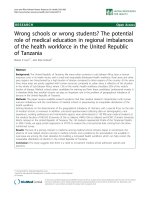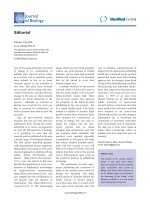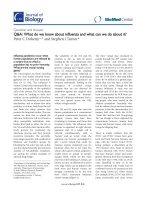Báo cáo sinh học: "Influenza: one or two more questions" pdf
Bạn đang xem bản rút gọn của tài liệu. Xem và tải ngay bản đầy đủ của tài liệu tại đây (53.72 KB, 2 trang )
Editorial
IInnfflluueennzzaa:: oonnee oorr ttwwoo mmoorree qquueessttiioonnss
Miranda Robertson
When we asked Peter Doherty to
write a question-and-answer piece on
influenza [1], Australia, where he is
based, had one reported case of
influenza A (H1N1). At the time of
writing this editorial, Australia has
more than 1,200 cases (though to
date no deaths) and has triggered the
announcement by WHO of a global
pandemic.
Received wisdom has it that
pathogens are not generally lethal to
the hosts they normally infect,
because they could not survive if
they were. Pathogenicity thus
becomes adapted to a level at which
the host survives to become
reinfected (or to produce young that
become infected). The most notable
example of such adaptation is in the
herpesviruses, which have evolved a
quite extraordinary repertoire of
devices for avoiding human
immunity and with which most
human adults in the Western world
are chronically infected.
Herpesviruses persist through
latency. Influenza virus belongs to a
different strategic class, which
proliferates rapidly and escapes in
coughs and sneezes, leaving the host
immune. Most humans survive
infection with human influenza
viruses; but the adaptive truce may
break down when the human viruses
recombine with viruses of avian or
swine origin: hence the high human
mortality associated with the H5N1
avian influenza virus that emerged
into public consciousness in 2005.
The so-called swine H1N1 influenza
virus that is the cause of the current
pandemic is apparently a triple-
reassortant, with genes of swine,
human and avian origin [2,3].
Unlike H5N1 it is readily
transmissible between humans, but
it seems - so far at least - otherwise
less uncouth, and in most people
causes only mild disease; so perhaps
in respect both of transmissibility
and of pathogenicity it reflects its
human rather than its swine or avian
origins. What makes this virus
particularly dangerous, as Peter
Doherty and Stephen Turner explain
in their Q&A in this issue of Journal
of Biology [1], is simply that most of
us are not immune to it, and it was
not, until now, on the agenda for
inclusion in the seasonal influenza
vaccine programme.
It is probably the level - or rather the
distribution - of population
immunity that also partly accounts
for the atypical pattern of mortality
of pandemic as against the usual
seasonal influenza. Whereas seasonal
influenza is more likely to kill the
old, pandemic influenza (including
the present H1N1 influenza) tends
preferentially to kill the young. This
is thought to be because older
individuals are likely to have some
level of immunity due to cross-
protective antibodies - that is,
antibodies against similar features of
other, in this case past, influenza
viruses [4]. (I ought however to
restate that disease due to influenza
A (H1N1) seems generally mild; and
indeed mortality is almost certainly
even lower than it seems, because it
is highly likely that many infected
individuals never bother to consult a
doctor and the number of people
actually infected therefore probably
substantially exceeds the number
reported.)
The options for vaccine development
are discussed by Doherty and Turner;
but for the coming (or in the
Southern hemisphere, current) flu
season, the traditional methods will
have to suffice. Among the problems
in developing current influenza
vaccines, notoriously, is the tendency
of the virus to mutate rapidly so that
variants can escape detection by
otherwise immune individuals (see
[1]). Influenza A (H1N1) however
seems relatively homogeneous
antigenically (see [3]), and the main
obstacle to rapid manufacture of the
large number of doses that will be
required for effective population
protection is the painfully
cumbersome method by which
influenza vaccines are produced (see
[1]). Hence the interest in new
adjuvants.
An adjuvant, in immunology, is a
substance that increases the strength
of an adaptive immune response.
Adaptive immune responses are
immune responses focused on
molecular features specific to a given
pathogen (operationally defined as
antigens) and that are induced by
exposure and confer lasting
immunity. The induction of adaptive
immunity is the basis for
vaccination, and all currently
effective vaccines work by inducing
the production of antibodies
(although antibodies are not the
only effector mechanism of the
adaptive immune response: see [1]).
Journal of Biology
2009,
88::
45
The use of an adjuvant could greatly
reduce the amount of vaccine
needed, and new adjuvants are being
tested for use in influenza vaccines.
How do adjuvants work? In
principle, the answer is clear and
biologically elegant [5]. Adaptive
immune responses depend upon the
selective activation and proliferation
of circulating lymphocytes bearing
receptors that recognize specific
antigens, including, but not
exclusively, molecules expressed by
pathogens. Lymphocytes however
cannot be activated by antigen alone,
and require a second signal which is
delivered by cells of the innate
immune system, which recognize
conserved molecular features
common to all members of
particular classes of pathogens. The
innate immune system thus focuses
adaptive immunity on pathogens.
Adjuvants activate the innate
immune system. The molecular
mechanism of this adjuvant effect is
understood for inflammatory
responses of the adaptive immune
system, which are invoked by a
family of receptors (TLRs) that are
expressed by innate immune cells
and recognize a wide range of
distinctive features of pathogens.
TLR ligands however are too
dangerous for use in human vaccines
(because of the inflammatory
responses they invoke), and for
many vaccines adjuvants are
unnecessary, because the killed
organisms themselves have intrinsic
adjuvant activity - that is, they
themselves have features that activate
innate immunity. This is the case for
influenza virus in current vaccine
preparations. Where adjuvant is
necessary, either because intrinsic
activity is too low, or in vaccines
based on purified components that
have lost their adjuvanticity in
purification, the only adjuvant
currently in use in human vaccines is
alum - a general term for salts of
aluminium, which have been in use
in human vaccines since early in the
20
th
century and that invoke good
antibody responses. How does alum
work? We do not know. New
adjuvants in preparation for use in
influenza vaccines include oil-in-
water emulsions; we do not know
how they work either.
It is known that distinct types of
pathogen tend to evoke distinct
kinds of adaptive immune response -
both different kinds of cell and
different kinds of antibody -
specialized to eliminate pathogens
with different properties and
methods of invasion and
proliferation. Protection from
influenza virus depends, as Doherty
and Turner explain, on neutralizing
antibodies that prevent the virus
from entering cells. Recent evidence
implicates intracellular components
of the innate immune system, which
are being recognized in increasing
numbers, in the adjuvant effects of
alum (see [5]). So it seems likely that
the riddle of the adjuvanticity of
alum, and of the oil-and-water
emulsions that may be deployed in
influenza vaccines, once solved, will
answer some important outstanding
questions about how innate immune
responses fine-tune adaptive ones.
Miranda Robertson, Editor
RReeffeerreenncceess
1. Doherty PC, Turner SJ:
QQ&&AA:: WWhhaatt ddoo
wwee kknnooww aabboouutt iinnfflluueennzzaa aanndd wwhhaatt ccaann
wwee ddoo aabboouutt iitt??
J Biol
2009,
88
:46.
2. Trifinov V, Khiabanian H, Rabadan R:
GGeeooggrraapphhiicc DDeeppeennddeennccee,, SSuurrvveeiillllaannccee,,
aanndd OOrriiggiinnss ooff tthhee 22000099 IInnfflluueennzzaa AA
((HH11NN11)) VViirruuss
N Engl J Med
2009, in
press.
3. Garten RJ, Davis CT, Russell CA, Shu
B, Lindstrom S, Balish A, Sessions WM,
Xu X, Skepner E, Deyde V, Okomo-
Adhiambo M, Gubareva L, Barnes J,
Smith CB, Emery SL, Hillman MJ,
Rivailler P, Smagala J, de Graaf M,
Burke DF, Fouchier RA, Pappas C,
Alpuche-Aranda CM, López-Gatell H,
Olivera H, López I, Myers CA, Faix D,
Blair PJ, Yu C
et al.
:
AAnniitteeggeenniicc aanndd
GGeenneettiicc CChhaarraacctteerriissttiiccss ooff SSwwiinnee
OOrriiggiinn 22000099 AA((HH11NN11)) IInnfflluueennzzaa VViirruusseess
CCiirrccuullaattiinngg iinn HHuummaannss
Science
2009, in
press.
4. Miller MA, Viboud C, Balinska M,
Simonsen L:
TThhee SSiiggnnaattuurree FFeeaattuurreess ooff
IInnfflluueennzzaa PPaannddeemmiiccss IImmpplliiccaattiioonnss ffoorr
PPoolliiccyy
N Engl J Med
2009, in press.
5. McKee AS, Munks MW, Marrack P:
HHooww ddoo aaddjjuuvvaannttss wwoorrkk?? IImmppoorrttaanntt
ccoonnssiiddeerraattiioonnss ffoorr tthhee nneeww ggeenneerraattiioonn
ooff aaddjjuuvvaannttss
Immunity
2007,
2277
:687-
690.
Published: 12 June 2009
Journal of Biology
2009,
88::
45
(doi:10.1186/jbiol158)
The electronic version of this article is the
complete one and can be found online at
/>© 2009 BioMed Central Ltd
45.2
Journal of Biology
2009, Volume 8, Article 45 Robertson />Journal of Biology
2009,
88::
45









